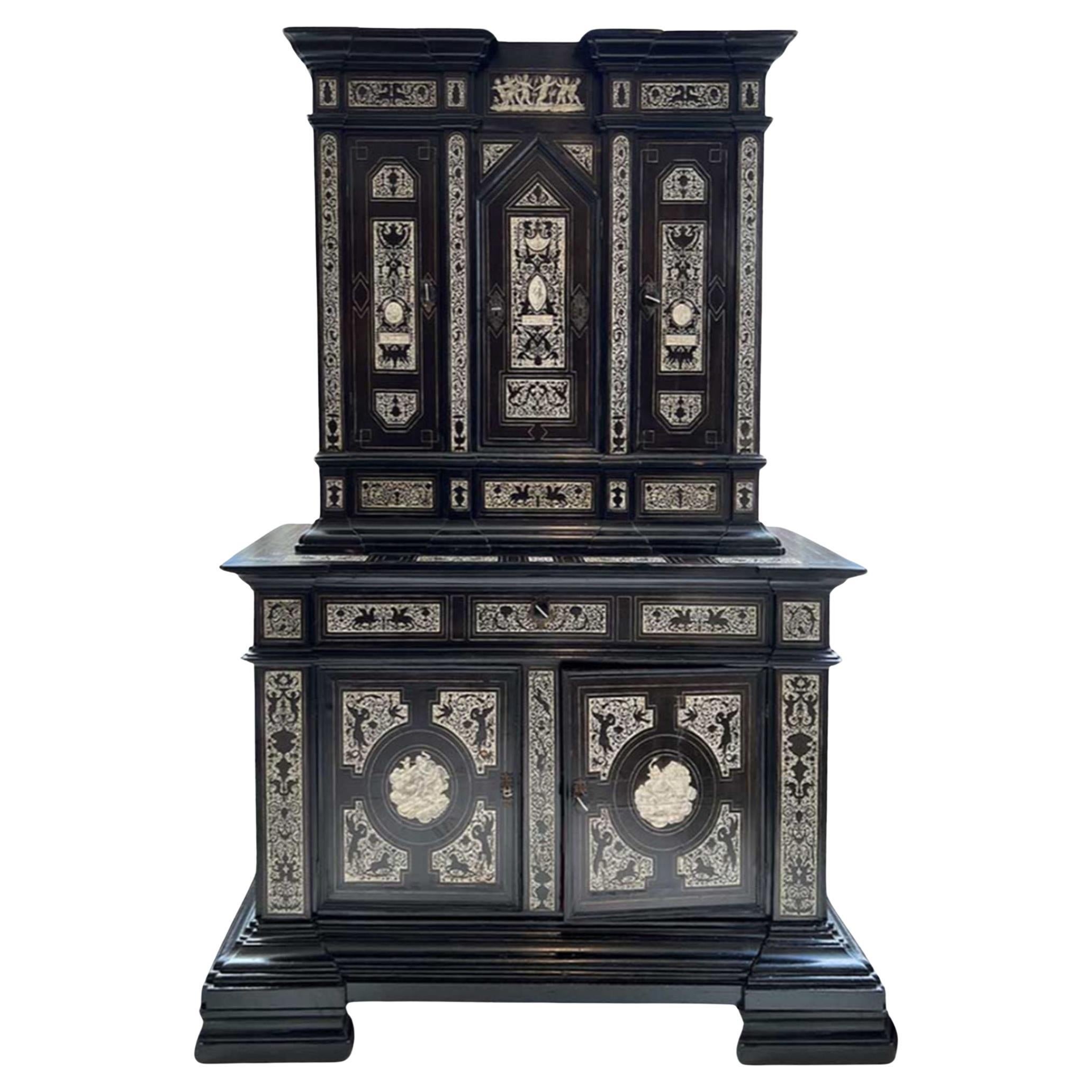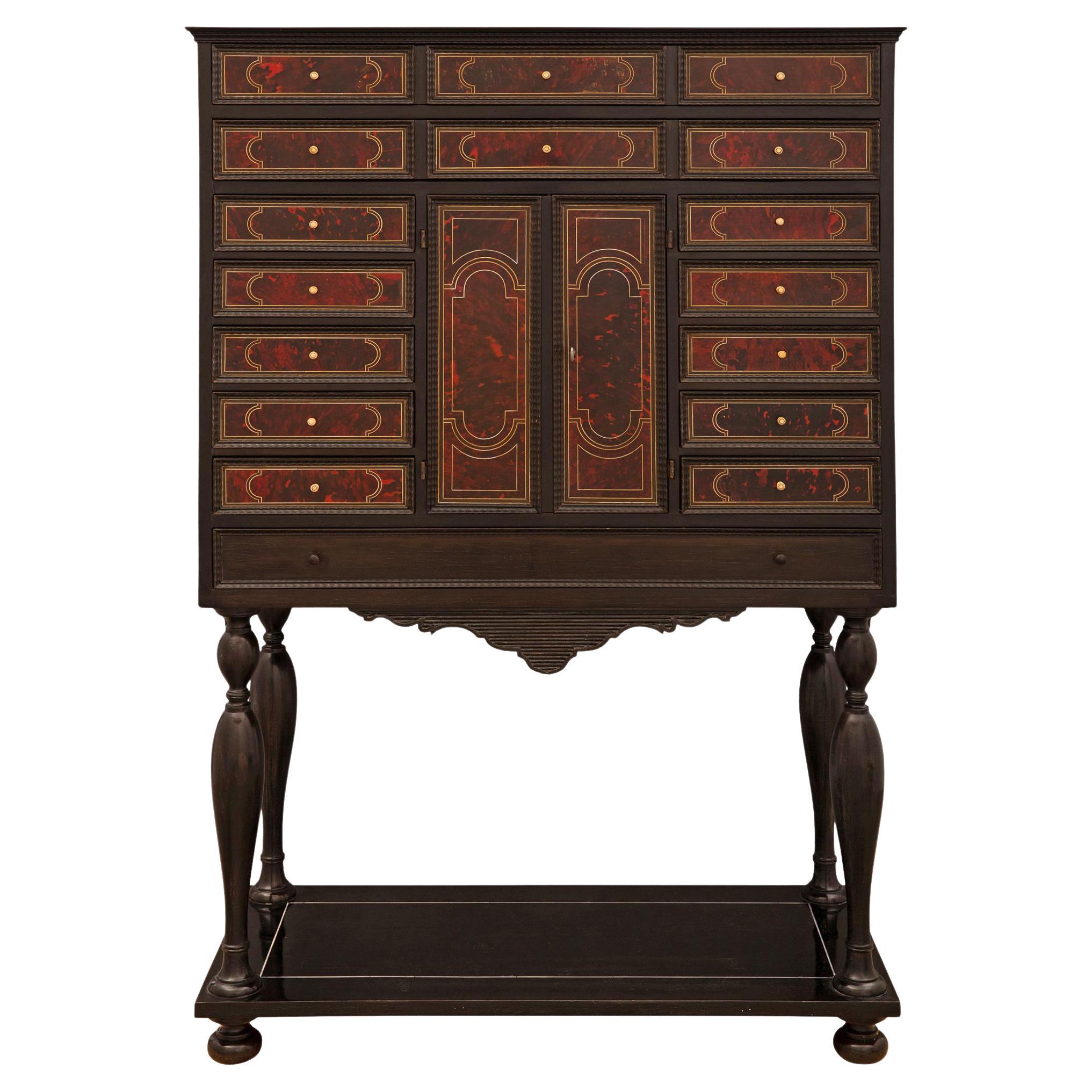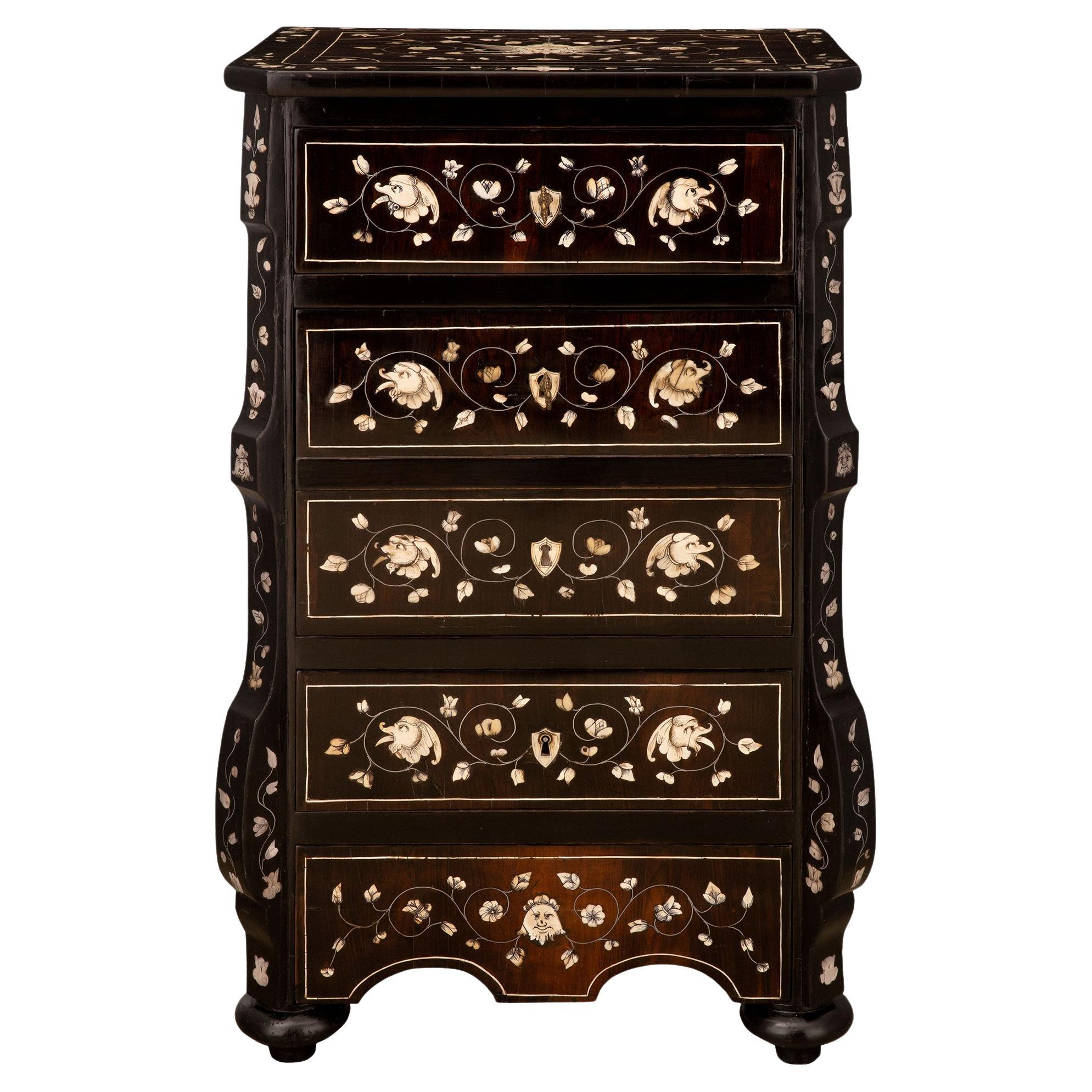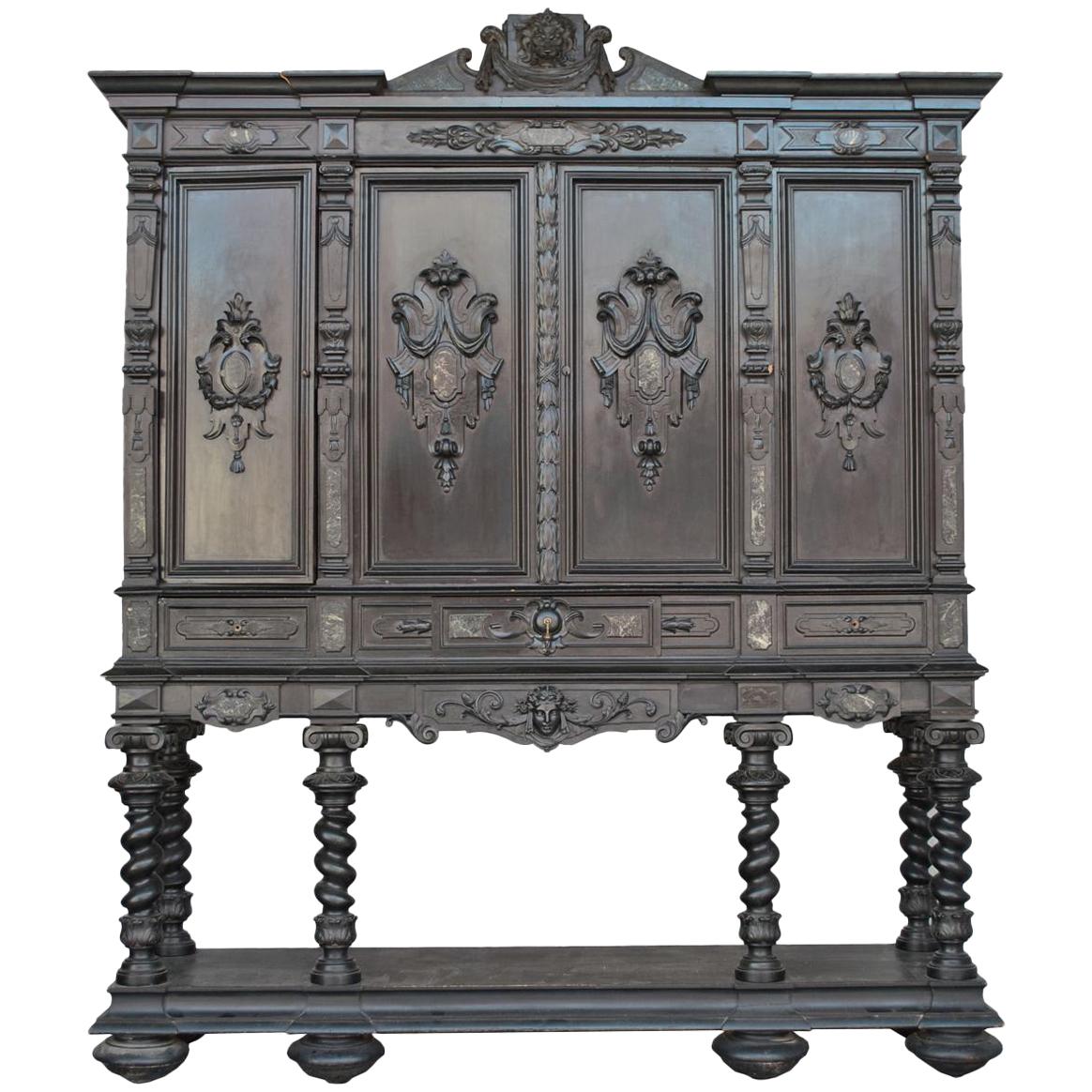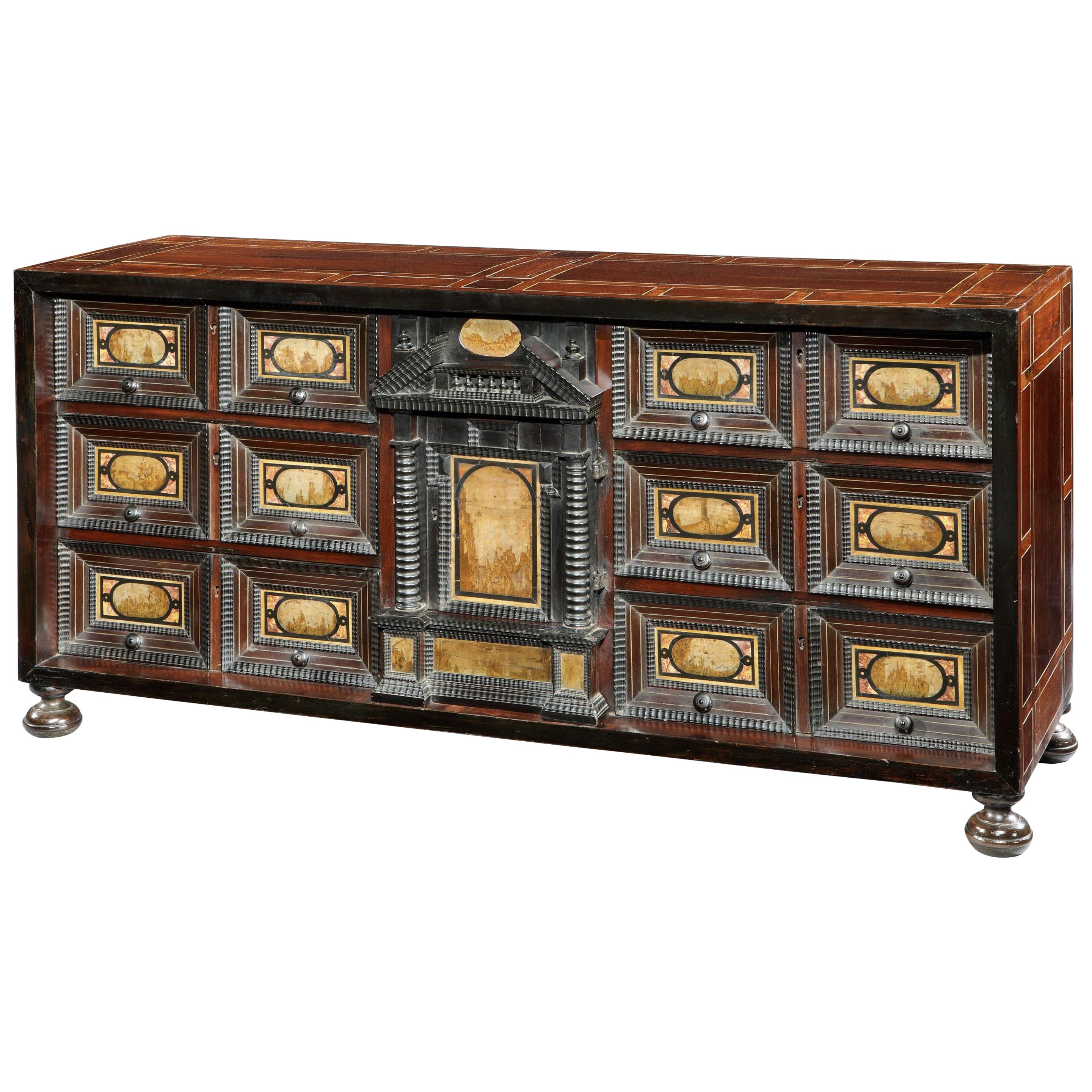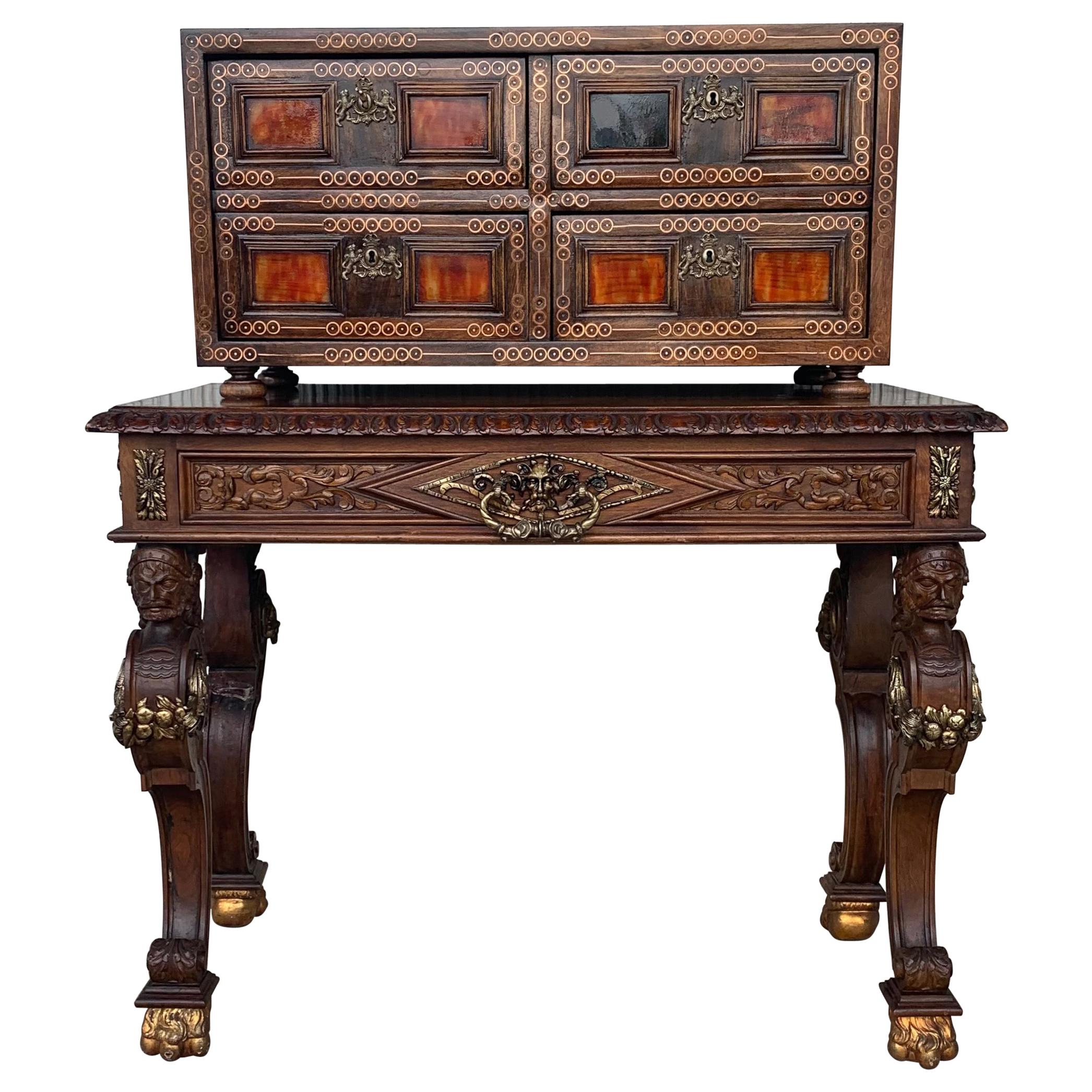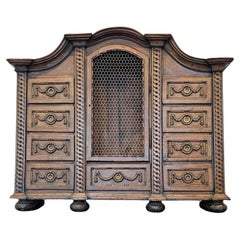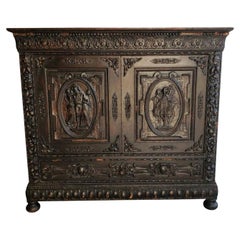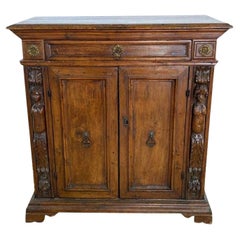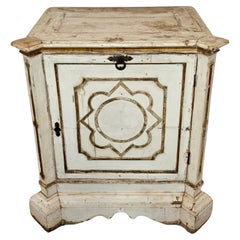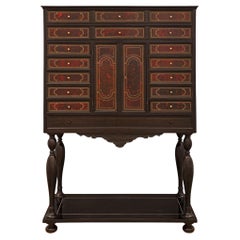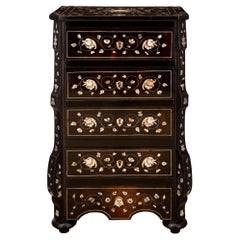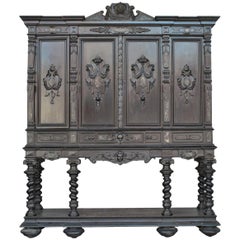Articoli simili a 17th Century Italian Milano Renaissance Period Bone Ivory Ebony Tabletop Cabinet
Vuoi altre immagini o video?
Richiedi altre immagini o video al venditore
1 di 21
17th Century Italian Milano Renaissance Period Bone Ivory Ebony Tabletop Cabinet
8339,10 €
Informazioni sull’articolo
A scarce nearly 400 year old fine quality Italian Lombard ebony rosewood bone and ivory tabletop curiosity cabinet with warm rich beautifully aged patina and interesting provenance. circa 1650
Milan, Lombardy region of Northern Italy, dating to the early to mid 17th century.
Nothing evokes the Renaissance era better than these rare authentic small table cabinets with their refined decorations, extraordinary workmanship, and rare exotic luxurious materials. Precious objects, the cabinet itself has become a jewel, highly prized and shrouded in mystery, they illustrate the epitome of refinement, elegance, and sophistication, showcasing the very finest quality craftsmanship, skilled workmanship, and highly specialized artistic inlay work of the 17th century
Exceptionally executed handcrafted Milanese work, this most precious table cabinet stands out for having such detailed and elaborate engraving work, as well as the exhibition style open-chest rectangular box form, elaborately decorated, featuring visually striking contrasting hand carved and engraved natural bone and ivory filets, marquetry plaques and banding. The dovetailed walnut open-front rectangular case veneered in exotic ebony and rosewood precious woods, fitted with seven drawers including a lower row with three simulated drawer-fronts constituting a single drawer, surrounding a central door opening to reveal niche compartment topped with a pair of small drawers that thanks to an ingenious system allow access to a concealed secret drawer and hidden shelved compartment!
Extensively engraved inlays, stylized scrolling foliate rinceaux arabesque marquetry, blackened ebonized wood trim, affixed with the original ironwork and hardware, including steel ace of spade strap hinges and lock, intricate bronze pierced scrolled openwork spandel corner brackets, and ornate patinated brass lion mask drop-ring pulls, the case with visible dovetail joinery to the top, large framed diamond inlay to the flanks, unfinished verso, all raised on tall turned onion bun feet.
- PROVENANCE / ACQUISITION:
Property from the Collection of Frederick H. Schrader.
Who acquired it from:
Tom Stansbury Antiques, Newport Beach, California;
Acquired from the above owner through the highly reputable auction house Heritage Auctions, Dallas, Texas. 2025 April 17 Sophisticated Palate: Fine & Decorative Arts from the Collection of Frederick H. Schrader, Napa Valley Signature Auction catalog #8210, lot #61046
Fred Schrader is often described as one of the "bad boys" of Napa Valley, a title that reflects his adventurous spirit and unconventional approach to life. In addition to producing many of the world’s finest Cabernet Sauvignons – first with Colgin Cellars, then with Schrader Cellars – Fred Schrader has been an art dealer and collector since the 1970s, and he has traveled the world in pursuit of treasures.
- DIMENSIONS: (approx)
17.5" High, 21.125" Wide, 12" Deep;
(44.5 x 53.7 x 30.5 cm)
- HISTORY:
The cabinet was a furniture replacing the typical two bodies sculpted buffets of the 16th century. It became in the 17th century a pageantry furniture highly appreciated by the greatest sponsors of this period, such as Marie de Medici or the Cardinal Mazarin, that had a collection of more than 20 pieces.
Initially linked to the taste for medals and coins collections of the Renaissance period, the cabinet became itself a object that can be admired thanks to its panels decorated with paintings, precious woods marquetry, ivory, Boulle marquetry, pietra dura, scagliola, etc...
The history of these cabinets is complex and the manufacture was developed in many countries, notably Germany, Holland, Italy, England and France. With the creation of Oriental Indies Companies, occidental models were also built from various elements including lacquer panels and then exported in Europe.
The origin of this type of cabinet is believed to be Dutch. Some craftsmen from the Holy Roman Empire such as Theodore de Voghel and Iacobus Fiamengo were sent to the royal armory of Naples to make rifle and crossbow stocks for the service of the Spanish Habsburgs.
Given the success of this luxurious production, they decided to respond to a growing demand by producing pieces for civilians, in particular precious cabinets for wealthy merchants stopping over in the port.
To do this, they hired "intagliatore d'avoli" such as the engraver Giovanni Battista de Curtis, as well as ironworkers and goldsmiths to create the rich mounts for these travel cabinets.
Several pieces commissioned by the Court and documented are now preserved in Italian museums.
After the revolt of 1647 and the proclamation of the Neapolitan Republic, the production center followed the Spanish court and moved further north to the Duchy of Milan.
Until 1713, the kings of Spain remained Dukes of Milan and made the city one of the richest artistic centers in Europe, developing the arms trade, textiles and especially the banking sector.
In addition to the minting of gold coins, Lombardy became the European capital of finance.
Later, similarly styled cabinets spread through Europe and were enjoyed by royalty, nobility, and wealthy merchants, including the Flemish ceremonial Flemish Antwerp cabinet on stand, German Wunderkammer and Kunstkast Art Cabinet, English scientific collection and specimen cabinet, similar Austrian / South German Augsburg marquetry table cabinet intended for the storage of small rare objects such as exotic shells, geode stones, coral, medals, the very fine gilded bronze ormolu French jewelery casket, petite Indo Portuguese colonial dropfront tabletop chest of drawers, campaign slope, and the very large Morrish inspired Spanish Vargueno traveling writing box desk.
Our example is characteristic of the beginning of this rich luxurious Lombard production, its beautiful state of conservation, delicateness, fine intricacies, and the rare presence of open-case visible drawers with the lack of the typical fall-front panel make this quite the scarcity and a desired object on the market.
**Additional photos available upon request**
- CONDITION REPORT:
A superb museum quality example, in overall fine condition, especially considering its age.
Attractive appearance, with nicely aged warm rich dark patina, original antique character marks and charm throughout. Wear commensurate with age, use and handling, including minor stable splits, surface scuffs, scratches, nicks and abrasions. Some minor age related separation present and a few drawers show typical warping. The interior drawer lining has areas of minor peeling and there is evidence of possible prior repair to a drawer joint. Overall truly remarkable! Delivered lightly cleaned, waxed, ready for immediate use and multi-generational enjoyment!
Guaranteed to elevate any space, it's sure to add refined elegant sophistication, classic rustic warmth, depth, rich antique character and unique historical interest!
- Dimensioni:Altezza: 44,45 cm (17,5 in)Larghezza: 53,66 cm (21,125 in)Profondità: 30,48 cm (12 in)
- Stile:Rinascimento (Del periodo)
- Materiali e tecniche:Osso,Ottone,Bronzo,Ebano,Avorio,Pero,Palissandro,Noce,Calco,Ebanizzato,Intagliato a mano,Fatto a mano,Intarsio,Falegnameria,Marqueterie,Tornito,Impiallacciato
- Luogo di origine:
- Periodo:
- Data di produzione:circa 1650
- Condizioni:Usura compatibile con l’età e l’utilizzo. Lievi mancanze. Lieve sbiadimento. A superb museum quality example, in overall fine condition, especially considering its age. Attractive appearance w/warm rich dark patina/original antique character. Wear commensurate w/ age/use. Please see photos & description for detailed report.
- Località del venditore:Forney, TX
- Numero di riferimento:1stDibs: LU5977245433742
Informazioni sul venditore
4,8
Venditore Platino
Venditori Premium con valutazione 4.7+ e tempi di risposta entro 24 ore
Fondazione nel 2013
Venditore 1stDibs dal 2021
294 vendite su 1stDibs
Tempo di risposta standard: <1 ora
- SpedizioneRecupero del preventivo…Spedizione da: Forney, TX
- Politica di reso
Alcune parti di questa pagina sono state tradotte automaticamente. 1stDibs non può garantire che le traduzioni siano corrette. L’inglese è la lingua predefinita del sito.
Garanzia di autenticità
Nell’improbabile caso in cui si verifichi un problema con l’autenticità di un articolo, contattaci entro un anno per ottenere un rimborso completo. DettagliGaranzia di rimborso
Se il tuo articolo non corrisponde alla descrizione, è danneggiato durante il trasporto o non arriva, contattaci entro 7 giorni per un rimborso completo. DettagliAnnullamento entro 24 ore
Hai un periodo di tolleranza di 24 ore per annullare il tuo acquisto, senza necessità di fornire spiegazioni.Venditori professionali selezionati
I nostri venditori di livello internazionale devono aderire a rigorosi standard di servizio e qualità, garantendo l’integrità delle inserzioni.Garanzia miglior prezzo
Se scopri che un venditore ha pubblicato altrove lo stesso articolo a un prezzo più basso, applicheremo lo stesso prezzo.Consegna globale affidabile
La nostra rete di vettori leader del settore offre opzioni di spedizione specializzate in tutto il mondo, inclusa la consegna personalizzata.Altro da questo venditore
Mostra tuttoTabernacolo da tavolo in Oak intagliato del XVIII secolo
Un antico gabinetto di curiosità barocco francese intagliato in quercia, del XVIII secolo o precedente, con una forma architettonica con un'elaborata cornice modellata, sopra una nic...
Categoria
Di antiquariato/d’epoca, XVIII secolo, Francese, Barocco, Mobili conteni...
Materiali
Ottone
Credenza rinascimentale italiana del XIX secolo
Una rara credenza rinascimentale italiana in rovere e pelle con una patina calda e ricca.
Nato all'inizio del XIX secolo, squisitamente artigianale ed eccezionalmente eseguito, p...
Categoria
Di antiquariato/d’epoca, Inizio XIX secolo, Europeo, Neorinascimentale, ...
Materiali
Pelle, Quercia
Armadio in noce intagliato italiano del XVIII secolo
Raro cassettone/credenza in noce del XVIII secolo, di epoca rinascimentale, con influenze neoclassiche, dotato di due elaborate colonne con statue figurate e decorate con elementi ar...
Categoria
Di antiquariato/d’epoca, XVIII secolo, Rinascimento, Credenze
Materiali
Similoro
Armadio a un'anta dipinto italiano del XIX secolo
Raro e unico nel suo genere, un antico mobile italiano dipinto e marmorizzato, con una splendida patina invecchiata e afflitta. 1830 circa
Realizzata a mano in Italia a metà del XIX...
Categoria
Di antiquariato/d’epoca, Metà XIX secolo, Italiano, Barocco, Armadietti
Materiali
Legno, Pino, Legno dorato
Mobile ad angolo intarsiato barocco italiano dei primi del Novecento
Armadio angolare in noce italiano, con cornice modanata, cassa triangolare, ante superiori e inferiori con pannelli in intarsio a contrasto, apertura per rivelare l'interno a ripiani...
Categoria
Inizio XX secolo, Barocco, Mobili ad angolo
Materiali
Noce
Antique Italian Renaissance Era Brass Mounted Walnut Table Cabinet Wall Cupboard
A rare and unusual antique Italian walnut table-top cabinet (now also wall hanging cupboard), 17th century and later elements, with handsome warm rich dark patina and interesting pro...
Categoria
Di antiquariato/d’epoca, XVII secolo, Italiano, Rinascimento, Mobili con...
Materiali
Ottone, Ferro
Ti potrebbe interessare anche
Mobile italiano del XVIII secolo con intarsi in osso
Ammira questo straordinario mobile di Fernando Pogliani di Milano che è una fantasia stratificata di ebano e osso. La parte anteriore è intessuta di intarsi che raffigurano angeli, c...
Categoria
Di antiquariato/d’epoca, XVIII secolo, Italiano, Mobili contenitori
Materiali
Osso, Legno
Armadietto per campioni in ebano, tartaruga e osso dell'inizio del XIX secolo
Uno spettacolare armadietto per campioni in ebano, tartaruga e osso dell'inizio del XIX secolo. L'armadio a due ante e ventidue cassetti è sollevato da eleganti piedini a conchiglia ...
Categoria
Di antiquariato/d’epoca, XIX secolo, Italiano, Mobili contenitori
Materiali
Osso, Tartaruga, Ebano
Armadio chiffonier in legno di palissandro e osso in legno di palissandro del XIX secolo.
Un affascinante mobile chiffonier in legno di palissandro, legno di frutta ebanizzato e osso del XIX secolo milanese, con timbro Brevete VF Paris. Il chiffonier a tre cassetti e un'a...
Categoria
Di antiquariato/d’epoca, XIX secolo, Italiano, Mobili contenitori
Materiali
Osso, Legno di alberi da frutto, Palissandro
Importante armadio in legno annerito in stile rinascimentale del XIX secolo
Mobili Chateau: Importante mobile in legno annerito in stile rinascimentale con colonne tortili. Riccamente intagliato. Decorazione con teste di donna e di leone. Lavoro di ebanister...
Categoria
Di antiquariato/d’epoca, XIX secolo, Francese, Rinascimento, Mobili cont...
Materiali
Legno
Mobile da tavolo, inizi del XVII secolo, Barocco italiano, Pietra Paesina montata su Walnu
Questo mobile fa parte di un piccolo gruppo realizzato negli anni Venti del Cinquecento, quando il gusto e la moda si orientarono verso l'uso della pietra paesina...
Categoria
Di antiquariato/d’epoca, Inizio XVII secolo, Italiano, Barocco, Mobili c...
Materiali
Marmo
Cabinet italiano del 20° su cavalletto, Bargueno barocco con intarsi e montature
Mobile italiano su tavolo. Legno di noce e palissandro, falco di mare, color bronzo e dorato, 20° secolo.
Esempio di piscina da tavolo posizionata su Ball and Ball con maniglie ai l...
Categoria
Inizio XX secolo, Italiano, Barocco, Buffet
Materiali
Bronzo
5231 € Prezzo promozionale
20% in meno
